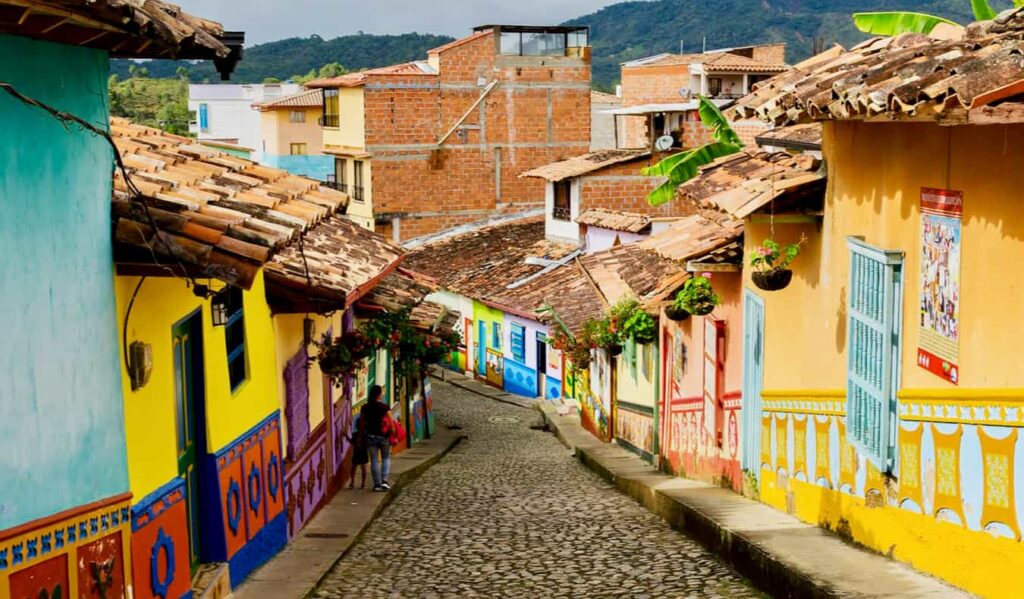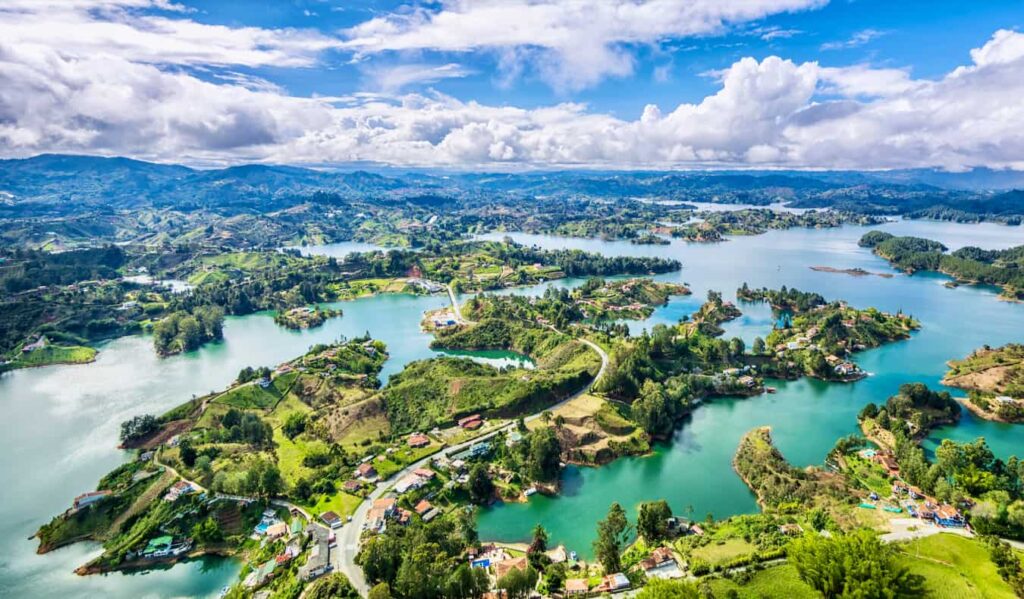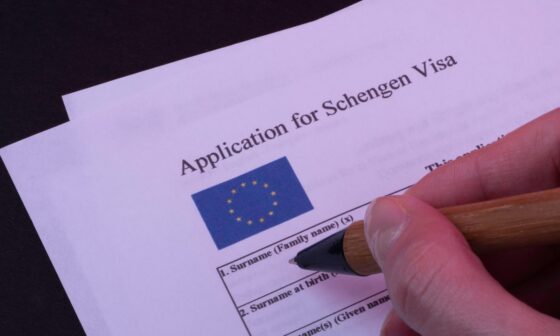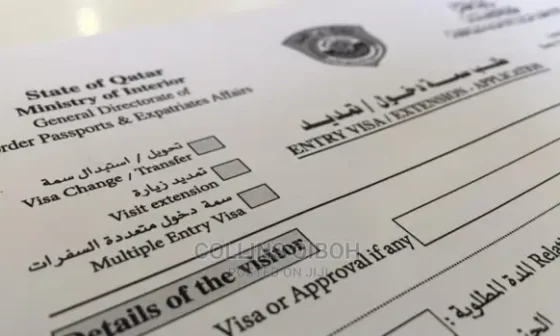When I first thought about the topic, “Is it safe to visit Colombia?” I was both excited and concerned. The appeal of its rich culture, beautiful landscapes, and dynamic towns was undeniable, but I couldn’t ignore the stories about safety problems. However, after conducting extensive research and personal experiences, I learned that Colombia has undergone incredible transformations. Let me share my experience, backed up by essential facts and personal observations, to help you plan your own vacation to Colombia with confidence.
Let’s start with some information concerning safety in Colombia.
Facts on Safety In Colombia
In terms of safety, Colombia still needs to be carefully considered.
Colombia was ranked 140th out of 163 countries in the most recent Global Peace Index, with high levels of access to weapons, homicides, internal conflict, and displacement.
In addition, Numbeo’s crowdsourced safety assessments ranked Colombia 115th out of 142 countries, level with Libya but ahead of Puerto Rico and the United States Virgin Islands.
The United States State Department has Colombia on level 3 (reconsider travel) status, mostly due to COVID-19, but it also states that Americans should avoid traveling to the following Colombia-Venezuela border due to risks of violence and terrorism:
- Arauca
- Norte de Santander (excluding Cúcuta).
The majority of these states and places are in the country’s south, near the border with Peru and Ecuador, which, while scenic, receives fewer tourists than the northern and coastal regions.
Santa Marta, Barranquilla, Tunja, Bucaramanga, the districts of Quindio, Risaralda, and Caldas, as well as the majority of significant cities, are all regarded as safe and allowed for visit in Colombia.
Is It Safe To Visit Colombia: Traveling in the cities

Bogota
Bogota is actually one of South America’s safest cities, with a lower violent crime rate than Indianapolis. There are dozens of unique neighborhoods filled with music, food, dancing, and art. It’s also one of the top coffee destinations in the globe.
Bogotá is not flawless. You may still be tagged for robbery if you take out your phone in the middle of the day. However, things are improving and becoming safe, and the city’s areas, such as the Chapinero district, may be extremely enjoyable.
However, Bogota is a city to be enjoyed cautiously at first, then more as you feel more at ease.
Medellin

Medellin has come a long way since its cocaine-fueled origins. The city was designated The World’s Most Innovative City in 2013 and was awarded the renowned Lee Kuan Yew World City Prize for Urban Development in 2016.
Advertisements
Aerial gondolas and outdoor escalators connect Medellin’s poorer hillside communities to the city center. There are parks, restaurants, galleries, delicious food, and live music everywhere.
The eco-árboles are among Medellin’s most outstanding features. Every hour, these revolutionary tree-shaped structures filter 22,000 cubic meters of air.
Cartagena
Cartagena, located on Colombia’s Caribbean coast, boasts miles of well-preserved architectural jewels from the country’s past, as well as some of South America’s finest beaches.
It is a stunning place that was just nominated to Travel & Leisure’s list of the world’s 25 most beautiful cities.
Cartagena, a popular destination for both Colombian and international visitors, is safe, enjoyable, and thrilling, but a little touristy.
Is It Safe To Visit Colombia: Traveling in the countryside
Colombia’s remote places can be spectacular, with thickly forested mountains, rainforests, waterfalls, and other natural features.
However, they can be dangerous for travelers.
According to the State Department, “the tourism industry is unevenly regulated, and safety inspections for equipment and facilities do not commonly occur.”
As a result, necessary signage to warn of dangers may not be there, and trained medical personnel, particularly paramedics, may not be present.
“Appropriate medical treatment is typically available only in/near major cities and even then, response times may be drastically different from what travelers are accustomed to in the United States,” the State Department said.
As a result, the State Department states that “U.S. citizens are encouraged to purchase medical evacuation insurance.”
Advertisements
Is It Safe To Visit Colombia Today?
Colombia has worked hard to improve its safety during the last decade. According to the World Bank, the country’s murder rate has decreased by more than half since the early 2000s. Cities such as Bogotá and Medellín have experienced significant increases in safety. Despite this, many individuals maintain outmoded perceptions of Colombia.
At first, I was concerned due to Colombia’s history. But, after hearing favorable feedback from other tourists and reviewing the data, I decided to go for it. The figures suggested a considerably safer country than I had anticipated.
Let’s examine Colombia’s safety carefully.
#1. Popular Tourist Destinations
Colombia’s top tourist destinations all have their own unique safety records:
- Bogotá: The capital city has much improved, particularly in neighborhoods like as La Candelaria, which is both safe and active.
- Medellín: Medellín has transformed from a crime-ridden city to a popular destination. Comuna 13 and other neighborhoods are now safe, with plenty of street art and music.
- Cartagena: Cartagena is known for its historic sites and lovely coastline, and it is typically safe, particularly in tourist areas.
In 2023, Bogotá’s safety rating rose to 45.28, indicating improved public safety.
In Bogotá, I explored La Candelaria, which felt safe even at night, and the residents were quite nice.
#2. Tourist Attractions
Some lesser-known locations in Colombia are also safe and amazing:
- Coffee Region: Towns such as Salento and Manizales are picturesque and serene. The coffee farms are an absolute must-see.
- Pacific Coast: Nuquí and Bahía Solano provide breathtaking natural beauty. With proper planning, you may safely enjoy these remote regions.
According to the UN, coca planting, which is associated with crime, has dropped in certain areas, making them safer.
My visit to Salento was fantastic. Staying on a coffee farm made me feel safe and welcome in the local community.
Practical Tips for Safe Travel in Colombia
#1. Be Prepared
Understanding the local safety conditions is critical. Here are a few tips:
- Stay Updated: Check your government’s travel advice and local news.
- Use Reputable Service: Choose hotels and travel companies that have received positive reviews.
- Blend in: Don’t flaunt your wealth; dress modestly and be mindful of your surroundings.
Using a Travel Safety Checklist Template can help you stay organized and avoid overlooking any vital safety precautions.
2. Engage with Locals
Connecting with the locals can make your journey safer and more enjoyable.
- Learn basic Spanish: It promotes communication and respect.
- Ask for Advice: Locals can provide valuable information on safe sites and activities.
- Attend Community Activities: Participate in local events to have a deeper understanding of the culture and establish positive relationships.
Learning a few Spanish phrases greatly helped me. Locals appreciated it, and it made my vacation easier and more enjoyable.
#3. Note your surroundings
Colombia, like the other countries in the region, expects you to be aware of your immediate surroundings. Criminals typically work in bunches, often around tourist attractions. Thieves will try to distract you while accomplices steal your money.
Avoid less-popular, non-tourist places at night. In fact, don’t walk alone anywhere at night; stick with the crowds, acquire instructions from reliable sources (such as hotel front-desk workers), and inform those sources of your intended destination.
Do not take food or beverages from strangers. In Colombia, it is possible to spike drinks.
#4. Transportation
Colombia’s taxis are generally safe. After a brief absence, Uber is back, but it functions more like a car-hiring business than the ride-sharing service you may be accustomed to.
Don’t drive on remote highways at night. Aside from the fact that the roads can be winding, rocky, and poorly marked, hijackings and other crimes may occur.
#5. Petty crime
Don’t fall for the scam in which “undercover police officers” seek to verify your cash to “see if it’s counterfeit”—even if they show you ID. It is nearly always a hoax.
Consider carrying a battered, outdated wallet that you always keep in your front pocket. If you carry a purse, consider one with a long strap that you can step on to avoid purse theft.
In any case, keep your money and vital papers spread out, and consider wearing a money belt or an infinity scarf to conceal them.
#6. Kidnappings
Kidnappings still occur in Colombia. One prevalent type of kidnapping occurs when a tourist enters a taxi. Armed criminals enter the taxi and force the tourist to drive around town, stealing money from cash machines or running up debit card balances until they are maxed out.
One strategy to mitigate the impact of this type of kidnapping is to bring a credit card with a low limit on vacation and leave the majority of your cash safely in your hotel room.
#7. Terrorist activity
The State Department emphasizes that, while the Colombian government reached a peace accord with the country’s major insurgent group, other groups remain active in the country.
Particularly, “the National Liberation Army (ELN), the Revolutionary Armed Forces of Colombia – People’s Army (FARC-EP), and Segunda Marquetalia terrorist organizations continue plotting and executing attacks.”
As a result, it is advisable to check news reports before traveling to specific locations in the country.
#8. Sexual harassment
Catcalling and sexual harassment are frequent in this country, as they are in others in the region. The best method to deal with this is to ignore it and carry on.
#9. Health
Colombia’s biggest cities, particularly Bogota and Medellin, are renowned for their high water quality. However, drinking tap water in the Colombian countryside might be hazardous. It’s best to bring your own water filtration equipment.
Most Colombian tourists do not face a significant danger of mosquito-borne illnesses, thanks in large part to the high altitudes of Bogota and Medellin.
However, if you are pregnant or considering becoming pregnant, see your doctor before visiting Colombia.
On the other side, many American visitors to Colombia do not require any additional vaccines. To be safe, see your doctor before flying.
Discovering Colombia’s Hidden Treasures
#1. Community programs
In Colombia, several community programs have enhanced safety.
- Medellín’s Metro Cable: This cable car system connects remote areas, lowering crime and promoting local economies.
- Bogotá’s Ciclovía: Every Sunday, main streets are closed to cars to promote safe walking and cycling.
Riding the Metro Cable in Medellín was an incredible experience. It provided excellent views and demonstrated how urban planning may enhance safety.
#2. Ecotourism
Colombia’s ecotourism initiatives have improved the safety of natural reserves.
- Tayrona National Park: Strict laws safeguard both visitors and the ecosystem.
- Amazon Rainforest: Guided tours with local experts provide a safe and educational experience.
Ecotourism in Colombia is increasing by 20% every year, demonstrating the country’s dedication to safe and sustainable travel.
The visit to Tayrona National Park was a highlight. The guided tour was safe, and the park’s natural splendor was breathtaking.
Other Safety Tips for Colombia
Here are some additional tips to avoid violence in Colombia:
- Do not flash money or valuables.
- Dress cautiously to blend in and not stand out.
- Do not use illegal taxis.
- Avoid traveling by bus.
- Don’t purchase or use drugs.
- Lock your car doors and keep the gasoline tank full.
Conclusion
Colombia is a lovely country that has made significant progress toward improving safety. With proper planning and research, you may enjoy its dynamic cities, tranquil landscapes, and welcoming communities. As you plan your trip, what are your primary concerns about visiting Colombia? Share your thoughts, and let’s continue the conversation!
Related Articles
- France Visa Application: Avoid These Critical Mistakes or Risk Denial
- STUDY ABROAD PROGRAMS IN 2024-2025: Costs & Requirements
- Top International Study Scholarships In 2024-2025 (+ Application Tips)
- BEST COUNTRIES TO STUDY MEDICINE IN 2024-2025
- Top Fully Funded International Scholarships for Nigerian Students In 2024-2025
References
Advertisements






